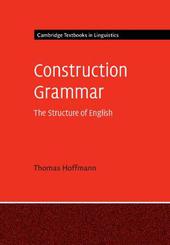
|
Construction Grammar
Hardback
Main Details
| Title |
Construction Grammar
|
| Authors and Contributors |
By (author) Thomas Hoffmann
|
| Series | Cambridge Textbooks in Linguistics |
|---|
| Physical Properties |
| Format:Hardback | | Pages:350 | | Dimensions(mm): Height 250,Width 175 |
|
| ISBN/Barcode |
9781107013490
|
| Classifications | Dewey:425 |
|---|
| Audience | |
|---|
| Illustrations |
Worked examples or Exercises
|
|
Publishing Details |
| Publisher |
Cambridge University Press
|
| Imprint |
Cambridge University Press
|
| NZ Release Date |
28 February 2023 |
| Publication Country |
United Kingdom
|
Description
What do speakers of a language have to know, and what can they 'figure out' on the basis of that knowledge, in order for them to use their language successfully? This is the question at the heart of Construction Grammar, an approach to the study of language that views all dimensions of language as equal contributors to shaping linguistic expressions. The trademark characteristic of Construction Grammar is the insight that language is a repertoire of more or less complex patterns - constructions - that integrate form and meaning. This textbook shows how a Construction Grammar approach can be used to analyse the English language, offering explanations for language acquisition, variation and change. It covers all levels of syntactic description, from word-formation and inflectional morphology to phrasal and clausal phenomena and information-structure constructions. Each chapter includes exercises and further readings, making it an accessible introduction for undergraduate students of linguistics and English language.
Author Biography
Thomas Hoffmann is Professor and Chair of English Language and Linguistics at the Catholic University Eichstatt-Ingolstadt as well as Furong Scholar Distinguished Chair Professor of Hunan Normal University. Notable publications include Preposition Placement in English (CUP, 2011), English Comparative Correlatives Interface (CUP, 2019) and The Oxford Handbook of Construction Grammar (co-edited with Trousdale, OUP).
|